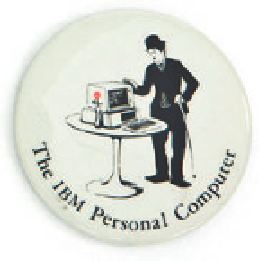Information Technology Reference
In-Depth Information
Fig. 8.12. The IBM PC. IBM's first personal computer arrived in 1981, more than five years after
personal microcomputers first arrived. However, the IBM name instantly legitimized the business
market and gave companies the confidence to invest in personal computers for word processing
and spreadsheet work. Although IBM had introduced the PC in 1981 with an advertising campaign
aimed at the general public, the IBM PC had its most profound impact in the corporate world.
Companies bought PCs in bulk, revolutionizing the role of computers in the office - and introduc-
ing MS-DOS to a vast user community. Unlike most previous IBM products, the PC incorporated
hardware and software from other companies. The PC also had an open architecture, which allowed
a thriving “PC clone” business to develop.
PC's five-year lifetime, IBM sold approximately 3 million systems, 250,000 in
one month alone in 1984.”
18
During the next few years, the IBM PC became an industry standard,
and most of the popular software packages were converted to run on the
machine (
Fig. 8.13
). In January 1983, the editors of
Time
magazine nominated
the IBM PC as their “Man of the Year.” The openness of the architecture and
the standardization of the operating system software encouraged other man-
ufacturers to produce
IBM-compatible computers
, also called
IBM clones
, which
copied the features of the IBM PC. IBM remained the technology leader and
produced several very successful successors to the original PC, most notably
its second-generation personal computer, the PC AT - the letters AT stood for
advanced technology
. The PC AT bus allowed expansion by the easy insertion
of printed circuit boards. In 1987 IBM tried to introduce some proprietary
technology into the PC market with the Personal System/2 or PS/2 computer,
replacing the now-standard but limited 16-bit PC AT bus with the more capa-
ble Micro Channel Architecture. Although IBM was willing to license the
technology to others, the strategy to regain a proprietary advantage was
not a success. Eventually the PC AT bus was superseded by the Peripheral
Component Interconnect (PCI) interface, an architecture created by an indus-
try consortium in 1993. As Mark Dean, a participant in the original IBM PC
design team, now says:
Fig. 8.13. An IBM PC button featuring a
Charlie Chaplin-like figure.
I'd have to admit that we lost sight of why the PC had become successful when
we went to the PS/2. To enable continued growth, we should have continued with
the model of building it so that other people can play. That would have allowed
us to stay in control of the market. When we did the PS/2, we lost control.
19
The Macintosh and Microsoft Windows
For all of the creativity at Xerox PARC in the 1970s, the success of per-
sonal computing - first with the Apple II and then with the IBM PC - owed
nothing to any of their research. This situation changed in 1979 when Steve
Jobs was invited to visit PARC. At the insistence of Xerox higher management,
PARC showed Jobs its Alto-based vision of the office of the future. Larry Tesler
remembers Jobs asking, “Why isn't Xerox marketing this? . . . You could blow
everybody away!”
20
In fact, microprocessor technology was not yet powerful
enough to support all the features he had seen. When Xerox released the Xerox
Star in 1981, it was not a commercial success despite wonderful reviews and its
many advanced features, such as the capability to network the computer to a


Search WWH ::

Custom Search